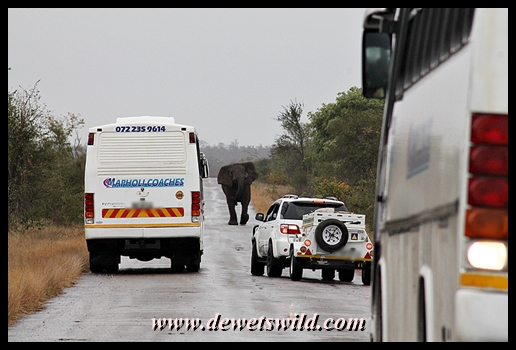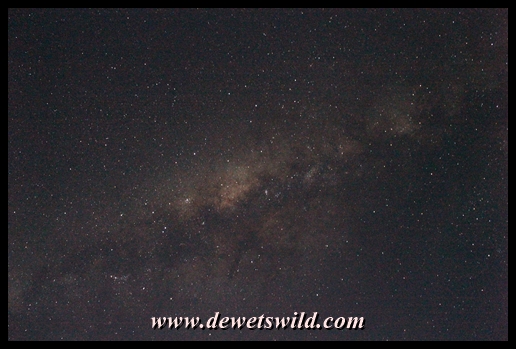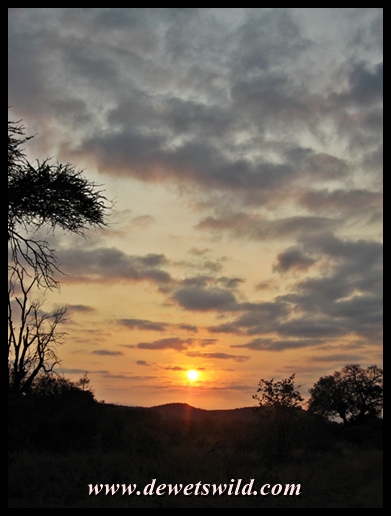Yes, we’ve been to the Kruger National Park again…
Our Heritage Day long weekend in Kruger started early, on the morning of Friday the 20th of September, waiting at Phalaborwa for the gate to open. Formalities completed, our chosen route took us along some of the less traveled gravel roads in the area to Letaba Rest Camp, where we’d spend our first night in the Park.
We spent the afternoon traversing the roads around the camp, soaking in the peaceful atmosphere and spending some time with our favourite Letaba resident, the big tusker Masthulele, and Hlahleni, one of the pretenders to the throne.
Come Saturday morning, we were on our way to Punda Maria, Kruger’s northern-most rest camp. A cold front was heading for the lowveld, and strong gusts of wind accompanied us all the way. Good sightings of elephants and some of Kruger’s rare antelope species, and a variety of other animals and birds, kept us entertained on the long drive northwards, and we arrived at “Punda”, where we were joined by Marilize’s parents and would be staying for the next three nights, just in time for the 2PM check-in time.
(We’ll dedicate a special post to Punda Maria soon – the camp and the area around it has a rich and fascinating history and plenty to offer nature lovers)
No visit to the north of the Kruger National Park would be complete without a pilgrimage to magical Pafuri. And so, despite the cold front having Kruger now firmly in its cold and wet grasp, this is where we headed on Sunday. Pafuri is a lush tropical paradise next to the Luvuvhu River, a bird watcher’s heaven, with regal nyala antelope around seemingly every corner.
That evening, a herd of elephant spent a lazy hour or two at the floodlit waterhole next to the camp fence. You’ll understand why I blame the waterhole and the hide that overlooks it for losing quite a bit of sleep this weekend – who can sleep when there’s this much action right on your doorstep!

Elephant herd at Punda Maria’s waterhole
We decided to visit recently re-opened Shingwedzi on our last full day in the Park. Shingwedzi Rest Camp and its immediate surroundings was hard-hit by the January 2013 floods, and we were curious to have a look at how our favourite Kruger camp has bounced back (some photos in our “Shingwedzi after the flood” post). Along the way an extremely aggressive elephant bull showed two buses and several SUV’s exactly who is in charge of this piece of wild Africa!

Elephant roadblock on the way to Shingwedzi
The Shingwedzi area is teeming with game at the moment. We had our first ever sighting of an albino impala, and a massive eland bull spending some time in the almost dry Mphongolo River was a welcome surprise, as these large but skittish antelope are rarely seen by visitors to the Kruger Park.
Almost back at Punda Maria that evening we had a thrilling encounter with a young lion walking past a herd of elephant on the Dzundwini Loop (photo here).

See the lion?
Dinner was followed by some more time spent photographing Punda Maria’s nightlife instead of sleeping…

Genet, Punda Maria

Milky Way above Punda Maria
But all good things come to an end and Kruger said goodbye with a magic sunrise on our way to Punda Maria Gate and back to Pretoria. Wouldn’t a scene like this also just convince that you need to get back here as soon as possible? Yes, we are already planning our next visit to Kruger National Park…

Punda Maria sunrise








































Your photos are amazing, would love to see a book someday with all your fantastic photos.
LikeLike
What a kind comment Joan, thank you very much and welcome here at de Wets Wild!
LikeLike
I look forward to reading more of your posts, your photos will keep me inspired through the irish winter!
LikeLike
Just beautiful!
LikeLike
Thanks a lot Milka!
LikeLike
Fantastiese foto’s! Dankie dat jy dit deel!
LikeLike
Baie dankie vir die gawe kommentaar Tersia, en baie welkom ook!
LikeLike
Absolutely amazing photos and an amazing trip. It’s one I’ve only dreamed of my whole life! Thanks for sharing these marvelous photos.
LikeLike
Thanks a lot Linda, and welcome here at de Wets Wild!
LikeLike
What a feast of pictures you provided in this post from that rather splendid portrait of an elephant’s head to that picture of that flock of quelea. Then penultimately finishing up with the milky way.
Beautiful!
LikeLike
You are very kind, thank you so much Chris!
LikeLike
Thanks for the post and images. We will be leaving for an almost two stay in the Northern part of the Kruger. Not sure what to expect because I am so spoiled with Kgalagadi which is a photographer’s paradise. But let us see.
LikeLike
If the sightings we had is any indication you’re sure to enjoy it very much Willem!
We’re waiting in anticipation to see the beautiful photographs you’ll be coming back with 😉
LikeLike
Hoe sal ek se op goeie Afrikaans… v*k… dit pluk aan my hart stringe… baie hard!!
Vantasties!! 😉
LikeLike
Baie dankie AJ! Kan dink dat dit jou sal laat terug verlang…
LikeLike
Fantastic galleries! Your photos are all great and a day in this park would be a dream…Thank you for sharing!
LikeLike
Thank you Lagottocattleya! Maybe someday that dream will turn to reality for you. Is your husband still planning on visiting South Africa in February?
LikeLike
Fantastic post the De Wets, very good read and images. thanks for sharing
LikeLike
Thank you very much Derek, always nice getting a comment from you!
LikeLike
A wonderful selection of shots and so good to see the elephant pix. Looks like pure magic to get out into the bush at Kruger…..
LikeLike
Absolutely Liz! Don’t we live in the most beautiful country on earth!? Thanks for the very kind remarks as well!
LikeLike
Wonderful post! I would go everyday!
LikeLike
Now that would be our deepest wish come true Kathryn! Thank you for the very kind comment, it is sincerely appreciated.
LikeLike
Me tooo! You are welcome indeed!
LikeLike
Wow what an amazingly beautiful collection of photographs Dries. Lovely. What you call Impala lillies we call Sabi Star or Desert Rose. Ours grows in a pot and has a huge root ball in which it stores its water. Unfortunately it’s had too much water with all the recent rains so it has put more effort into putting out foliage and less into flowering. Usually it’s covered in flowers. The Milky Way is just beautiful. It’s hard to chose a favorite among these beauties. The night time shots are very special. Such a richness in nature that you always share with us. Fabulous dear de Wets. 🙂
LikeLike
Thank you for the ever encouraging comments dear Joey, we really appreciate it so!
I am sure that sabie star of yours has a very special place in your heart?
LikeLike
So many great captures of these animals! What a treat for us 🙂 Thank you!
LikeLike
You’re too kind Amy, thank you very much!
LikeLike
Wow what a great Day you had with all these animals to Photograph.. 😀
LikeLike
Thanks for dropping by Harsha. Yes, Kruger’s a wonderful place and we’ve never been disappointed!
LikeLike